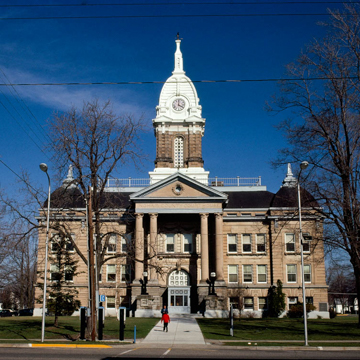Marking the seat of Ingham County government, the courthouse's tall, square, domed clock tower is visible for miles from the surrounding farmlands. The courthouse is sited in the center of a square and surrounded on three sides by commercial buildings. With its symmetrical massing, dramatic central tower, mansard roof, squat corner pavilions, columned portico, and rusticated light grayish-yellowish-brown sandstone, the courthouse is a noteworthy example of Beaux-Arts classical courthouse design. It was one of the first major commissions of Bowd (1865–1940), who later designed numerous public and academic buildings in southern Michigan. The Lansing architect was born and trained in England and began his career in 1883 in the offices of Gordon W. Lloyd in Detroit.
The interior of the courthouse pivots around a rotunda beneath the central tower. This circular hall gives access to county offices in each corner of the building and the entire interior is finished with oak woodwork and ornamental plasterwork. The courtroom is in the south portion of the second floor. It has been the site of several criminal trials on change of venue because of publicity—most notably the month-long trial concerning Detroit murders of July 26, 1967, during the riots, and documented in John Hersey's book The Algiers Motel Incident (1968). The present courthouse replaced a gabled brick building with a cupola erected in 1848.













